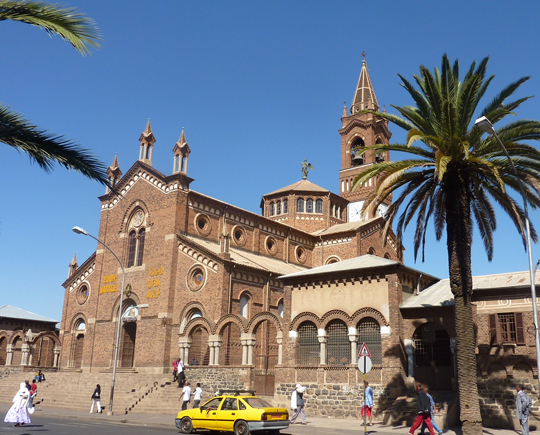Eritrea (ER)

1. Tourist visas for Eritrea are valid for 30 days.
2. Visa fee is $70 USD.
3. Visas can be obtained upon arrival at the airport.
4. Passport must be valid for at least 6 months.
### Step-by-Step Guide: How to Apply for a Tourist Visa to Eritrea
1. **Check Eligibility**:
- Ensure your nationality requires a visa to enter Eritrea.
2. **Gather Required Documents**:
- Valid passport (at least 6 months from the date of entry).
- Completed visa application form.
- Recent passport-sized photos.
- Proof of accommodation (hotel booking or invitation letter from a host in Eritrea).
- Travel itinerary (flight bookings).
- Proof of sufficient funds for the duration of your stay.
3. **Obtain the Visa Application Form**:
- Download the form from the Eritrean embassy or consulate website in your country.
- Alternatively, visit the embassy or consulate to get a physical copy.
4. **Fill Out the Application Form**:
- Complete all sections of the form accurately.
- Double-check for any errors or missing information.
5. **Pay the Visa Fee**:
Sure, here is a simplified version with separate links:
---
**Online Application Links for Eritrea Tourist Visa**
If you need to apply for a tourist visa to Eritrea online, you can use the following links:
1. **Eritrean Ministry of Foreign Affairs**
- [Eritrean Ministry of Foreign Affairs - Visa Information](http://www.eritrean-embassy.se/visa/)
2. **Eritrean Embassy in the USA**
- [Eritrean Embassy in the USA - Visa Services](http://www.eritrean-embassy.org/visa/)
Please visit these websites for detailed instructions and to start your application process.
---
This should help you easily navigate to the correct pages for your tourist visa application.
Sure, here's a simple and easy-to-read list of documents needed for a visa application to Eritrea:
1. **Passport**: Valid for at least six months from the date of entry.
2. **Visa Application Form**: Completed and signed.
3. **Passport Photos**: Two recent passport-sized photos.
4. **Proof of Accommodation**: Hotel reservation or invitation letter from a host in Eritrea.
5. **Travel Itinerary**: Detailed plan of your trip, including flight bookings.
6. **Proof of Sufficient Funds**: Bank statements or proof of financial support.
7. **Employment Letter**: If employed, a letter from your employer stating your position and salary.
8. **Travel Insurance**: Proof of travel insurance covering the duration of your stay.
9. **Cover Letter**: Explaining the purpose of your visit.
10. **Visa Fee**: Payment receipt for the visa application fee.
11. **Return Ticket**: Proof of a return
Sure, here are the steps to extend a visa in Eritrea in a simple and easy-to-understand way:
1. **Check Eligibility**: Make sure your visa type allows for an extension. Tourist visas are usually extendable.
2. **Gather Documents**: Collect necessary documents such as your current visa, passport, a recent passport-sized photo, and a completed visa extension application form.
3. **Visit Immigration Office**: Go to the Eritrean Department of Immigration and Nationality. It's usually located in the capital, Asmara.
4. **Submit Application**: Hand in your documents and application form to the immigration officers.
5. **Pay Fees**: There will be a fee for extending your visa. Pay this fee at the office.
6. **Wait for Approval**: The processing time can vary. You may need to wait a few days for your application to be processed.
7. **Collect Extended Visa**: Once approved, return to the immigration office to
Traveling to Eritrea involves a few specific requirements. First, you need a valid passport and a visa, which you should obtain before your trip as visas on arrival are not available.
For health, it's recommended to get vaccinated for Hepatitis A, Hepatitis B, Typhoid, and Yellow Fever. Yellow Fever vaccination is particularly important if you are coming from a country with a risk of Yellow Fever transmission.
Additionally, Eritrea requires a negative COVID-19 test taken within 72 hours before arrival.
Make sure to carry any necessary medications, as pharmacies may not have a wide range of supplies. It's also a good idea to have travel insurance that covers medical expenses.
Lastly, be aware of local customs and regulations. Eritrea has strict rules regarding photography, especially in sensitive areas, so always ask for permission before taking pictures.
By preparing these documents and health precautions, you can help ensure a smooth and safe trip to Eritrea.
When traveling to Eritrea, it's important to respect local laws and customs to ensure a smooth visit. Here are some key points to keep in mind:
1. **Photography**: Avoid taking photos of government buildings, military installations, and uniformed personnel. Always ask for permission before photographing locals.
2. **Dress Modestly**: Eritrea is a conservative country. Dress modestly, especially in rural areas and religious sites. Women should cover their shoulders and knees.
3. **Permits**: Travel outside the capital, Asmara, requires a permit from the Eritrean government. Plan ahead and obtain necessary permits for your travels.
4. **Currency**: The local currency is the Nakfa (ERN). It's illegal to exchange money outside of official banks and exchange bureaus. Credit cards are rarely accepted.
5. **Public Behavior**: Public displays of affection are frowned upon. Behave respectfully in public spaces.
6. **Religion**: Eritrea is home to various religions
Sure! Here are some quick and interesting facts about Eritrea:
1. **Location**: Eritrea is located in the Horn of Africa, bordered by Sudan, Ethiopia, and Djibouti, with a coastline along the Red Sea.
2. **Capital**: The capital city is Asmara, known for its well-preserved Italian colonial architecture.
3. **Independence**: Eritrea gained independence from Ethiopia in 1993 after a 30-year war.
4. **Languages**: The country has no official language, but Tigrinya, Arabic, and English are widely spoken.
5. **Population**: Eritrea has a diverse population of around 3.5 million people.
6. **Religion**: The main religions are Christianity and Islam.
7. **Climate**: Eritrea has a varied climate, from the hot coastal plains to the cooler highlands.
8. **Wildlife**: The Dahlak Archipelago, off the coast, is